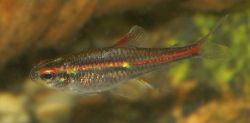Breeding Hemigrammus erythrozonus
Contents
Breeding Glowlight Tetras[edit]
Glowlight tetras breed similarly as most egg-scattering small fish. They have been bred in captivity as moderate level of difficulty. Breeding tank set up : A small 40L all glass tank with soft water hardness up to 8°dGH and carbonate hardness should not be higher that 2°dCH. Water temperature should be kept between 26° and 28 °C (78 F to 82 F) . Adding peat to the tank or filter will soften water and make it slightly acidic. The tank should have dim or no lighting. They spawn over fine-leaved plants. Java moss, Fontinalis and Vesicularia dubyana are suggested but not mandatory. The use of spawning mop made of woollen thread can also be used. 1 cm glass beads or a spawning grate will help at the bottom to protect eggs from being eaten by adults.
Parents Conditioning[edit]
Feed the pair kept separately with a variety of live foods, frozen food or dry food for a few weeks. When the female is well rounded transfer the pair to the breeding tank in the late afternoon hours. The spawning will occur in the following morning or the next day, if no spawning behaviour is shown after 3 days start over the conditioning of the pair.
Spawning behaviour[edit]
The male will swim around in a quick manner locking is fins when near the female. During the spawning act both fish roll over, when the female is the upside down position she ejects the eggs while the male fertilises them. Usually 120-150 eggs are dropped in plants and on the bottom. When the pair is done, they will be grazing for the eggs, they should be then removed.
Raising the fry[edit]
The eggs are light sensitive, so the breeding tank should be as dark as possible. Some believe the light contributes greatly to the eggs fungusing, though fungusing has more to do with cleanness of tank and water conditions. The fry will hatch in 20 to 25 hours. They should look like small slivers of glass. Fry can be feed with, infusoria, paramecium culture, crushed flakes and rotifers after they have used all the yolk sack. By the 4th day should be introduced very small portion of newly hatched brine shrimp. Young consume relatively large pieces of live food such as nauplii of brine shrimp. Later microworms can be added to the diet. Live food has the advantage of less pollution in the water, in case not consumed immediately.
Care of the breeding tank[edit]
Bottom sediment should always be removed and regular water changes done during the rearing period in order to avoid an accumulation of ammonium and nitrates which can be toxic to the fry. Although large quantities of fry will incubate in waters of low hardness, most of the fry may soon contract non-infectious, constitutional dropsy, and die within a short time. Those who survive will grow well. By the 12th day, they will show signs of a silver colouring. At three weeks of age, the fry will start showing their characteristic orange line and will be a size of about 1 cm. By two months they will be about 2 cm.
